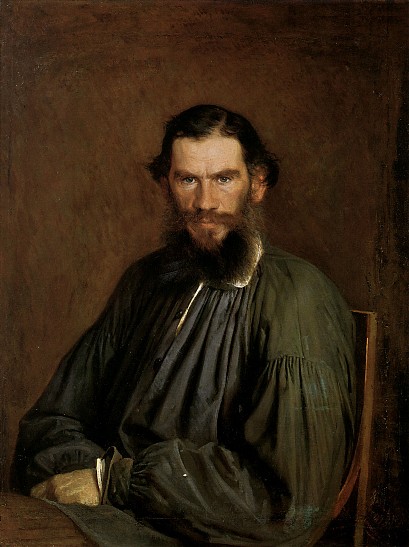Tolstoy, Leo
Tolstoy, Leo [Толстой, Лев; Tolstoj, Lev], b 28 August 1828 at Yasnaia Poliana, Tula gubernia, Russia, d 7 November 1910 at Astapovo railway station, Riazan gubernia, Russia. Russian novelist and thinker, author of War and Peace (1863–9), Anna Karenina (1873–7), The Death of Ivan Illich (1886), Resurrection (1899), and numerous religio-philosophical essays and treatises. His ethical precepts entailed a belief in the passive resistance to evil, the rejection of private property, the abolition of government and church authority, a personal God, and the supremacy of love in all spheres of life. His writings influenced many authors and intellectuals in Russia and abroad, including major figures such as George Bernard Shaw, Gandhi, Romain Rolland, and Guy de Maupassant. Among those promoting Tolstoy’s ideas in Ukraine the most prominent was his friend, the painter Mykola Ge.
Tolstoy exerted a significant influence on several Ukrainian authors. The majority of them assimilated his literary techniques and devices but rejected Tolstoy's weltanschauung. In ‘Autobiography,’ Ivan Franko acknowledged Tolstoy's influence on his prose of the 1870s. Olha Kobylianska also stated that under the influence of Tolstoy she wrote a number of stories and the novels Zemlia (Land, 1901) and Cherez kladku (Over the Footbridge, 1911). Quite prominent was Tolstoy's influence on Ukrainian historical novels written in the 20th century. They include Nalyvaiko (1940) and Khmel’nyts’kyi (1957) by Ivan Le, Semen Palii (1954) by Yurii Mushketyk, Homonila Ukraïna (Ukraine Was Astir, 1954) by Petro Panch, and Pereiaslavs’ka rada (The Pereiaslav Council, 1948) by Natan Rybak. Tolstoyan influences can also be discerned in some novels by socialist-realist authors presenting recent or contemporary events: Myr khatam—viina palatsam (Peace to Houses, War on Palaces, 1958) and Reve ta stohne Dnipr shyrokyi (The Broad Dnieper Roars and Groans, 1960) by Yurii Smolych, and Praporonostsi (The Standard-Bearers, 2 vols, 1947–8), Liudyna i zbroia (Man and Arms, 1960), and Tronka (The Sheep's Bell, 1963) by Oles Honchar.
The first translation of Tolstoy into Ukrainian was of his trilogy Childhood, Boyhood, and Youth, which appeared in 1894 in Lviv. Owing to Ivan Franko's efforts the following works of Tolstoy were published in Ukrainian: Resurrection (1901), The Kreuzer Sonata (1902), The Death of Ivan Illich (1903), The Cossacks (1906), and a host of essays and short stories. Under the Soviet regime Ukrainian translations of Tolstoy's works were published frequently, but they consisted mostly of reprints or writings for children. Translations of Tolstoy's major novels were issued with great delays. A translation of Anna Karenina appeared only in 1935, and a complete edition of War and Peace was not available until 1953. A 12-volume Ukrainian edition of Tolstoy's complete works was first published in 1960. The most accomplished translations of Tolstoy into Ukrainian were by Oleksii Kundzich.
Of the abundant studies of Tolstoy's influence on Ukrainian literature, the majority are articles dealing with his influence on individual authors, his translations into Ukrainian, or certain literary processes; they offer no detailed examination of his influence on Ukrainian literature as a whole. Much more comprehensive, although not exhaustive, are the monographs, including Nina Krutikova's study of Tolstoy and Ukrainian literature (1958), which is confined to the Ukrainian reception of Tolstoy in the 19th century, and A. Sakhaltuev's L.M. Tolstoi i ukraïns’ka literatura (L.M. Tolstoy and Ukrainian Literature, 1963), which outlines Tolstoy's influence on the writers of the 19th and 20th centuries and provides a brief outline of Ukrainian translations of his works.
Walter Smyrniw
[This article originally appeared in the Encyclopedia of Ukraine, vol. 5 (1993).]
.jpg)

.jpg)
